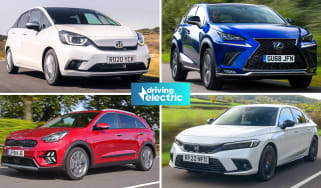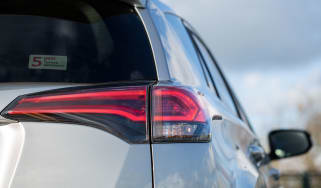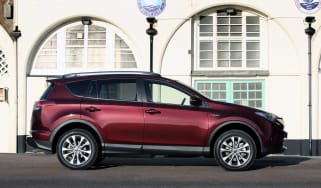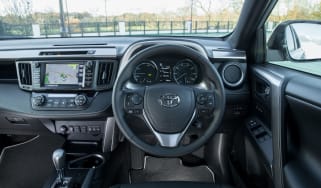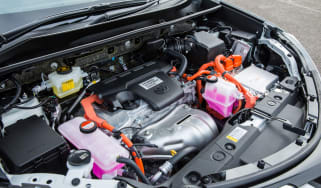Toyota RAV4 Hybrid review
The latest Toyota RAV4 is a striking-looking and efficient hybrid family SUV, but there are more versatile seven-seat alternatives for similar money
Pros
- Efficient around town
- Practical inside
- Low BiK tax
Cons
- Mediocre motorway MPG
- No seven-seat option
- Poor infotainment
| Car type | Fuel economy | CO2 emissions | 0-62mph |
|---|---|---|---|
| Hybrid | 48-50mpg | 126-132g/km | 8.1-8.4s |
While the original Toyota RAV4 made the classic SUV more compact and fun to drive, it’s got a little more sedate over the years. But the latest Toyota RAV4 hybrid seems to have brought back some of the original’s flair. Buyers aren’t short of choice; with plenty of rivals such as the Nissan Qashqai, Kia Sportage, Hyundai Tucson and Honda CR-V. To fight its corner, Toyota has had to up the ante by offering the RAV4 as a full-hybrid and plug-in hybrid, both of which we’ve driven, but it’s the former of which we’re focusing on here. The hybrid RAV4 offers good value and low running costs, plus no need to plug in to charge.
The benefit of the system used in the hybrid RAV4 is that it takes energy from the petrol engine and brakes (that would otherwise be wasted) to power the battery; a system that Toyota refers to as “self-charging”, given that there’s no need to plug in. That said, the battery is fairly small, so you’ll only get around a mile of zero-emissions driving; its main purpose is to take strain off the petrol engine and thus improve economy. For better electric range, you’d be better off with the plug-in hybrid with its bigger battery and lower company-car tax – but you need somewhere to plug it in overnight.
The first-generation RAV4’s design was eye-catching for its time, and the sharper-edged design cues, unique headlights and chunky wheelarches of the latest generation make it similarly striking for modern tastes, and an improvement over other previous iterations, which had begun to look mundane. The brand also offers the bold-looking Toyota C-HR with a similar powertrain, but it's not quite as practical as the RAV4.
The RAV4 hybrid has a 2.5-litre four-cylinder petrol engine under the bonnet, plus the electric motor and small battery. Horsepower, fuel economy, CO2 and acceleration figures differ slightly between the front and four-wheel drive versions, while a CVT automatic gearbox is the only transmission available. It's offered in the UK in five different trim levels: Icon, Design, Excel, Dynamic and Adventure (with Icon only being available in front-wheel-drive form).
The RAV4 manages to be both comfortable and reasonably engaging behind the wheel. The engine, however, isn’t the smoothest, and is quite noisy even under moderate acceleration which is likely as much down to the CVT automatic gearbox as the engine itself.
This car is even fairly capable off-road if you go for the four-wheel-drive option, so it’s a good choice if you find yourself regularly tackling a muddy yard or grassy lane in the countryside. But if you’re looking for an all-out off-roader, you’d be better off with a Jeep or Land Rover, which are more capable still. The Toyota is also not the best option if you plan to tow regularly, with a well-below-average 1,650kg capacity, compared to non-hybrid rivals that can manage from 2,000 to 2,500kg.
Inside, there's a decent amount of passenger and luggage room, combined with high interior trim quality. Although the RAV4 can't be said to be at the cutting edge of style or luxury, even compared to some rivals, it looks smart and has some great common-sense touches including rubberised grips on the inside of the door handles. As part of an update for 2023, the RAV4 now comes as standard with a 10.5-inch central touchscreen, wireless Apple Carplay and Android Auto, plus all but the base models also get a 12.3-inch digital driver's display, too.
It's a good balance of honest utility and straightforward, decent-looking materials and interior design. It is, however, well into the price territory of cars like the Skoda Kodiaq, which offer seven-seat versatility that the five-seat-only Toyota can't compete with.
The RAV4's hybrid-only status means it has a higher starting price than petrol or diesel-engined rivals, but that same hybrid powertrain gives it the low CO2 emissions that translate to affordable Benefit-in-Kind (BiK) tax for company-car users. Though plug-in hybrid alternatives such as the Kia Sportage PHEV will be even cheaper to run. At least we saw the RAV4 Hybrid return around 40mpg on the motorway, and closer to 45mpg in town, where the electric running really pays off.
Overall, the latest Toyota RAV4 is an impressive package, with those low company-car costs and a very roomy, practical and comfortable interior among its strongest attributes that make it a great family car. But it doesn't trouble the class leaders for luggage capacity, driving enjoyment and in particular in-car technology, so it's one to think carefully about before signing on the dotted line. For a more detailed look at the Toyota RAV4, read the rest of our in-depth review...




